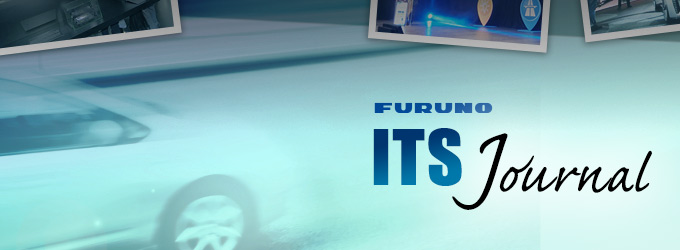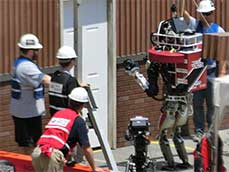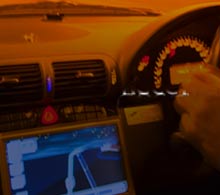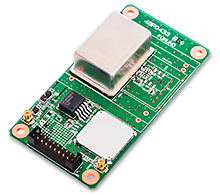Articles for ITS market Online Autonomous Driving Contest Enhancing development of Human Resources
 How programmer is running using Autoware software
How programmer is running using Autoware software
 Prize winner for autonomous driving AI challenge (quoted from related website)
Prize winner for autonomous driving AI challenge (quoted from related website)
Autonomous Driving and Technology Contest that targeted Food Delivery Services
In December 2020, there was an award ceremony for an interesting event leading to the future of autonomous driving.
It was "The 2nd Japan Automotive AI Challenge" sponsored by the Society of Automotive Engineers of Japan, Inc. (JSAE).
The Society of Automotive Engineers is the most prestigious academic society for automotive technology in Japan. Members are mainly from automobile manufacturers, parts suppliers, universities and other educational institutions.
Fellow at Advanced R&D and Engineering Company of Toyota, Mr. Seigo Kuzumaki, who is also the chairman of the conference committee and the program director for the government’s SIP Automated Driving Systems, pointed out the reality of the automotive industry, "We now have an urgent need to develop human resources on AI technology."
The automotive industry is entering a once every 100years "revolutionary period”. Engineers involved in software are increasingly important in the research and development of connected and autonomous driving technologies.
Under these circumstances, the AI challenge of autonomous driving was intended to attract not only the existing automotive industry, but also IT, and electrics-related industries. Also students interested in developing future automobiles with autonomous driving technology.
On March 24-25, 2019, the first tournament was held at the Chiba Experiment station (inside the Kashiwa Campus), which is affiliated with the Institute of Industrial Science, University of Tokyo.
The second tournament was scheduled to be held in June 2020, the same program as the 2019 conference, but it was cancelled due to the spread of the coronavirus infection.
Instead, an online competition was proposed.
The finals were held on September 23-November 6, 2020 by the top teams from the online simulation qualifying round, and the top teams from the 2nd AI Edge Contest, a collaborative competition.
The competition was designed as a case study for food delivery service. This is because many people are expecting deliveries by self-driving cars considering the viewpoint of logistics and disaster prevention during COVID19.
In this competition, the task was to deliver the ordered items quickly and politely without damaging the items while monitoring and clearing some issues with the autonomous vehicle.
According to the scenario, the participants should pass through checkpoints on a predetermined route.
The maximum speed is 30km/h, and the time limit is 5 minutes, beyond which you will be disqualified.
Collision with ground objects, vehicles, or pedestrians on the map also means disqualification. To avoid obstacles, you can pause or avoid without stopping while driving.
The software is an open source Autoware. Participants created source code to clear the driving scenario. After validating in the local environment, the source code was uploaded to the online environment.
However, the appearance timing of objects, vehicles, and pedestrians was set differently in the local environment and online environment, in order to enhance the competition.
The results were as follows.
The best award went to Team gatti from NTT Data Automobiligence Laboratories.
The time is 112.965 seconds.
The excellence prize is Shallow Learners from Toyota Motor (129.546 seconds).
The third prize, tomo123 from Sun Electronics (149.997 seconds).
Team gatti said, "We applied the techniques we normally used in our regular work. Taking a non-stop drive approach to avoid obstacles was effective in reducing time."
Shallow Learners is from Toyota Motor Corporation, but they are not engaged in developing autonomous driving or related research.
Tomo123 was surprised and said, "I was not expect to win at all." Unlike other prize teams, Tomo123 was an individual entry, and was the first time working with Autoware. It was quite a challenge at first, but he was able to take advantage of his previous IT-related knowledge to successfully win third place.
 The on-demand transportation "Kinsuke Taxi" in Eiheiji-cho. Photographed by the author
The on-demand transportation "Kinsuke Taxi" in Eiheiji-cho. Photographed by the author
Models for implementation: Eiheiji-cho, Fukui Prefecture and DARPA Robotics Challenge.
The author was also involved in the process of determining the implementation guidelines for the Autonomous Driving AI Challenge.
Here are the two proposals from the author.
The first one is to base testing on social problems. Therefore, the food delivery scenario was selected.
As an example, there is a food delivery service using on-demand traffic, which is practically operating in Eiheiji-cho, Fukui Prefecture. Toyota's minivans are typically used as a means of transportation for the elderly on their way to shopping or going to hospital. However, due to COVID19, they started running a limited-time business for delivering lunch boxes and other items from local restaurants to private homes. This on-demand transport uses a system called private paid passenger transportation, in which local residents serve as drivers.
Furthermore, in Eiheiji-cho a demonstration test of autonomous driving using a promenade on the site of an abandoned railway line is currently underway. It is supported by the Ministry of Economy, Trade and Industry and the Ministry of Land, Infrastructure and Transport. From the latter half of December, 2020, the system was put into practical use on about 2km section of the total 6km route which is mostly used for sightseeing to Eiheiji.
The author has been involved in various activities in the town as an "evolution ambassador" for the new transportation system in Eiheiji-cho.
Based on these actual experiences, he came up with the idea of applying AI to the contest, with the image of combining on-demand traffic and autonomous driving into one platform.
The second proposal is for disaster prevention. In terms of disaster prevention, the DARPA Robotics Challenge, a contest with disaster robots held by the U.S. Defense Advanced Research Projects Agency (DARPA) in 2015, was used as a reference.
The author was covering the final in a suburb of Los Angeles. It was assumed that robots perform a variety emergency response tasks to the accident at the Fukushima Daiichi Nuclear Power Plant.
Generally speaking, the social demand for autonomous driving needs to be considered in two ways, an individually owned vehicle and a service vehicle that is utilized by public transportation and logistics services.
In this online automotive AI challenge, it is expected that the participants had a sense of purpose to solve social issues and not just as a software development game competition.
It will be important to keep developing autonomous driving technology, while industry, government, and academia continue to collaborate on how it reflects in society. Regardless of testing in the real world with actual vehicles or in the online virtual world, it is also critical to involve local residents to participate in these discussions.
Writer introduction

Mr. Kenji Momota Automotive journalist
His major is the world automotive industry and he is also familiar with the energy industry, IT and the aging society problem as the related fields. He acts around the world based in Japan and USA and writes for the general magazines, the technology journals and the automotive related media etc.
He is also commentator of motor race and world's motor show on TV program based on his career of the driver of Indy Racing League and NASCAR. In recent years, he has been covering about a paradigm shift from developed countries to developing countries, the motorized vehicle like EV and the telematics.
FURUNO ITS Journal
Click here for the latest articles after 2022 (in Japanese)2022
- The "realistic" self-driving roadmap shown by the Japanese government and a hands-on report on the latest Subaru EyeSight X
- Will FCVs (Fuel Cell Vehicles) Become Popular? ~New Movement in Toyota and Honda~
- The 'Complete' online sales of new cars start in Japan. Will this new way of buying cars take root?
- Many Firsts! On-Site Report from Tokyo Auto Salon 2022 - The author, who knows what goes on behind the scenes, looks back on 40 years of history. -
2021
- "Moving toward zero traffic fatalities for four-wheeled and two-wheeled vehicles globally in 2050" ~Experience on Honda's latest safety technologies~
- Tsuneishi Shipbuilding's building and DX, an exclusive visit to the main factory
- Japan's Smart City: New Moves toward Practical Use
- When will self-driving buses (service cars) be put to "full-scale" practical use?
- Utilization vehicle data during disasters
- Toyota-led Connected Technology to Transform Commercial Vehicle Business -From light trucks to large trucks and buses-
- Toyota enters the connected car "Personalization" business
- Japanese automakers' carbon-neutral strategies swept up in ESG investment
- Drive experience of the latest autonomous vehicle models and advanced driving support systems
- Will carbon neutrality accelerate the trend to strengthen LCA (Life Cycle Assessment)?
- Semiconductor shortage exposes realities of the automotive industry
- Online Autonomous Driving Contest Enhancing development of Human Resources
2020
- What happens to CASE when gas cars are banned in Japan?
- When will Flying Cars be launched?
- Expectation vs. reality:Autonomous Driving in Japan
- V2X, Becoming increasingly important in autonomous driving
- Technology of Subaru “EyeSight X”
- Lifestyle-oriented French cars gain popularity in Japan
- Human-oriented smart cities are wanted
- MaaS and CASE, how would automotive industry change after COVID-19?
- The beginning of virtualization era, triggered by COVID-19
- Trend of EV shift and consumer demands
- TOYOTA Press conference about ADAS - Releasing algorithm for "sudden acceleration suppression during attempted sudden acceleration" free of charge -
- The Japanese automotive industry in 2020 - 3 turning points -
- "Using a smartphone while driving" and "Level 3 automated driving"
2019
- Motor show business model is at a turning point - Tokyo Motor Show Report -
- Commercialization and monetization of MaaS - ITS World Congress Singapore Report -
- Android Automotive pays attention to V2X - Report from the Frankfurt Motor Show 2019 in Germany -
- Automobile Distribution Revolution and DCM (Data Communication Module)
- Connected business potential and newly proposed "eMaaS" by Honda
- 5G services for practical use are multiplying
- Connectivity technologies attracting attention due to frequent traffic accidents
- Shanghai Motor Show report -SUV, EV, Automated car & 5G-
- Drone Business roadmap and updates to Michibiki (Quasi-Zenith Satellite System)
- MaaS (Mobility as a Service) "town development." Full-scale promotion for a national project
- CES organizer states "Data Period in 2020s." Transformation of the Automotive Industry in CES, US "-CES2019 Report-"
- "Return to Origin" directed towards the age of change, automatic operation and connectivity
2018
- New proposal for Private Car Automated Driving Level and other Hot 5G Technology Topics
- Standardized EV charging infrastructure concerns in Europe, US, Japan and China - Kobe EVS 31 field report -
- Touring a pure car carrier and a test drive of the latest hybrid car
- Planning stage products are exhibited at the newly established visualized mobility service "TOYOTA MOBILITY SHOWROOM".
- Potential “Community Car-share” program promoted by local residents
- CES Asia Report 2108
- Companies attempt new Vehicle-to-Infrastructure communications, including traffic volume measurements and vehicle positioning. -ITS Asia Pacific Forum in Fukuoka-
- Geneva show in Switzerland. Flying cars and MaaS (Mobility as a Service) were hot topics.
- EV (Electric Vehicle) proposals by country
- MaaS competition through service mobilization, M & A and technical field collaboration is accelerating. - The CES 2018 Report -
2017
- Big data’s initiative and fight for the automotive industry. Cooperation among companies becomes increasingly important.
- Connected car and road-to-vehicle communication automatic operation
- ETC (Electronic Toll Collection) and ETC2.0. Current situation and projected future
- Rapid development of sharing economy
- Germany is first to recognize level 3 automated driving
- ITS EU 2017 Field Reports -Automatic Operation and the eCall-
- From Infotainment to ITS, the competitive area is spreading in the car big data industry.
- GTC (GPU Technology Conference) Report and the de facto standardization of AI (artificial intelligence)
- Renesas' new challenge! "e-AI Solution" and "Renesas Autonomy"
- The Automobile industry is shifting from a manufacturing industry to a service industry.
- The movement toward accident countermeasures for aging drivers in Japan
- Fusion of ride sharing and fully automated driving is advancing in the USA.
2016
- Overview of the Quasi-Zenith Satellite System (QZSS) and advancements toward full-scale practical use including the Tokyo Olympic Games - G-space EXPO 2016 report-
- Japan’s automated driving project "SIP-adus" will be a large demonstration experiment.
- The International Home Care & Rehabilitation Exhibition. There were many car manufactures with exhibits booths at this show.
- Japanese car manufacturers starting to concentrate on strengthening the ADAS system
- A new movement of legislation for autonomous cars
- Cyber Security and “AGL”, the new OS for automotive are hot topics in the connected car industry
- “High precision 3D map” the key future of autonomous car and pedestrian dead reckoning
- Chinese “BAT” is accelerating their business in the EV (Electric Vehicle) market
- Tesla's original connection to Taiwan and the new transportation system technologies.
- "The main topic" of the Geneva Motor Show was how to strengthen "pedestrian protection"
- The probe data business is getting more competitive
- Reporting directly from the 2016 CES show "Data services will soon become the main revenue source of automotive industry"
2015
- Do the automated driving systems need the GNSS (Global Navigation Satellite System) ?
- ETC Version 2.0 is coming soon. A new service was announced at the Tokyo Motor Show and the possibility that is could be used as a device for older drivers.
- "Connected Horizon" and "eHorizon". Germany's leading parts supplier accelerates strengthening of "Big Data" for business



 Running route
Running route DARPA robotics challenge (1/2). Photographed by the author
DARPA robotics challenge (1/2). Photographed by the author DARPA robotics challenge (2/2). Photographed by the author
DARPA robotics challenge (2/2). Photographed by the author GPS/GNSS Receiver&Chips and Modules (positioning and timing)
GPS/GNSS Receiver&Chips and Modules (positioning and timing)